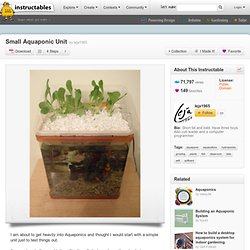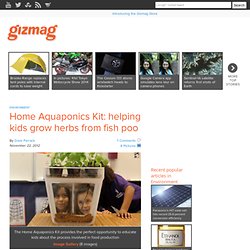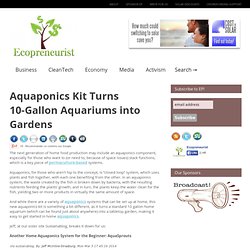

Endless Food Systems: Fish-Powered Aquaponic Gardens. On the third season of Doomsday Preppers, we follow Chad Hudspeth as he builds an underground escape tunnel.

And while the 140-foot pipeline may be one of his biggest preps, it's certainly not his only one. Brooklyn Bagwell recently caught up with Chad at the Self-Reliance and Preparedness Expo in Prescott Valley, Arizona, where he was offering a line of aquaponics products from his company, Endless Food Systems. We asked Chad to tell us a little about aquaponics and why it is such a crucial prep to have. Why Aquaponics? When I first started prepping, I soon realized that storing up freeze dried foods is not only expensive, but not a great plan for long-term survival.
When I came across an endless way to grow food called aquaponics, it revolutionized my way of thinking in terms of long-term survival. An aquaponic garden is something that will benefit your family right away, and will also be crucial in the event of a long-term food crisis. So How Does Aquaponics Work? Small Aquaponic Unit. The Grow Bed is where the plants will grow.

The grow bed medium can be anything that will support the plants. I used fine rocks but blue metal and so on is ok. Just clean it first. In this example I have used an old plastic storage box. I drilled two large holes on one side. 1 For the Pump to go through 1 as an over flow valve in case drain holes fail. Along the one side I drilled a series of holes to drain the water back to the tank. Then simply placed the container on top of the tank at an angle to allow the drain holes to be flow back into tank and the pump and over flow to be near the top. The pump I am using is the standard pump that came with the tank. After washing the grow medium I place it in the grow bed. Now I let the system run to ensure it doesn't over flow and look for any issues. Home Aquaponics Kit: helping kids grow herbs from fish poo. Many of us have completely lost sight of where the food we eat comes from.

As long as the product is sitting on the shelf when we visit the supermarket, we pay little attention to the process that led to it being there. The Home Aquaponics Kit is designed to counter this ignorance by educating children in the process involved in growing and cultivating food using a self-cleaning fish tank and a self-maintaining herb garden. View all Aquaponics, a combination of hydroponics and aquaculture, has been around for centuries, but apart from in rice paddies, it's not a farming practice in widespread use today. We've recently seen attempts to bring aquaponics to the masses – like the Fishy Farm – and the Home Aquaponics Kit from Back To The Roots is the latest to take on the challenge. A blog for and about eco and social entrepreneurs, startups, cleantech, web 2.0 and disruptive business ideas.
The next generation of home food production may include an aquaponics component, especially for those who want to (or need to, because of space issues) stack functions, which is a key piece of permaculture-based systems.

Aquaponics, for those who aren’t hip to the concept, is “closed loop” system, which uses plants and fish together, with each one benefiting from the other. In an aquaponics system, the waste created by the fish is broken down by bacteria, with the resulting nutrients feeding the plants’ growth, and in turn, the plants keep the water clean for the fish, yielding two or more products in virtually the same amount of space. And while there are a variety of aquaponics systems that can be set up at home, this new aquaponics kit is something a bit different, as it turns a standard 10 gallon home aquarium (which can be found just about anywhere) into a tabletop garden, making it easy to get started in home aquaponics.
Jeff, at our sister site Sustainablog, breaks it down for us: